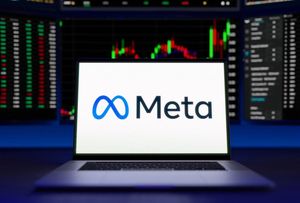
New York, NY – October 20, 2025 – After a period of significant market turbulence, U.S. stock markets opened notably higher today, signaling a robust rebound and renewed investor confidence. This positive shift across the Dow Jones Industrial Average, S&P 500, and Nasdaq Composite marks a crucial turning point, as markets appear to be shrugging off recent anxieties stemming from credit concerns, trade disputes, and interest rate uncertainty. The upturn suggests a potential "massive Wall Street comeback" as the fourth quarter of 2025 progresses, with investors focusing on strong corporate fundamentals and optimistic economic indicators.
The immediate implications of this strong open are largely positive, pointing towards a potential easing of the persistent volatility that has characterized recent trading weeks. This momentum reflects a growing belief among investors that underlying corporate performance remains solid and that the economy may be heading towards a more stable trajectory, despite lingering geopolitical and domestic political uncertainties. While analysts remain cautious about the potential for renewed volatility, the current "risk-on" sentiment indicates a significant shift in market psychology.
Navigating the Storm: A Detailed Look at the Market's Recent Journey
Today's buoyant market open is a welcome change following a bumpy trading period. The CBOE Volatility Index (VIX), often dubbed Wall Street's "fear gauge," had surged to its highest level in nearly six months, reflecting deep-seated market anxiety. This volatility was primarily fueled by a confluence of factors, including escalating trade wars with China, Canada, and Mexico, which introduced widespread uncertainty regarding global supply chains and corporate profitability. Additionally, resurfacing recession fears, concerns over slowing economic growth, and the specter of "sticky inflation" coupled with the Federal Reserve's (FED) ambiguous stance on interest rate cuts, kept investors on edge.
The timeline leading up to this moment saw a series of challenging events. Recent weeks were marred by credit concerns emanating from regional U.S. banks, creating "credit-fueled tremors" across the financial sector. An ongoing government shutdown further exacerbated market instability by delaying the release of crucial economic data, leaving investors without vital information to assess market health. Looming concerns about a potential "AI bubble" also contributed to cautious sentiment. However, the tide began to turn as strong third-quarter corporate earnings reports started to emerge, particularly from key players in the financial and technology sectors.
Key players driving today's positive sentiment include major financial institutions like Bank of America (NYSE: BAC) and Morgan Stanley (NYSE: MS), which reported robust double-digit profit growth, easing recession fears. Technology giants such as Nvidia (NASDAQ: NVDA), Microsoft (NASDAQ: MSFT), and Apple (NASDAQ: AAPL) have also extended their gains, spearheading a tech-led recovery. Initial market reactions have been overwhelmingly positive, with all major indices registering significant gains. The market's ability to shrug off recent anxieties related to credit and trade, coupled with optimism for a political resolution to the government shutdown, underscores a renewed focus on fundamental economic strengths and the prospect of a more favorable interest rate environment.
Winners and Losers: Corporate Fortunes in a Shifting Market
The current market environment, characterized by a return to "risk-on" sentiment and hopes for interest rate cuts, is poised to create distinct winners and losers among public companies. Technology companies, particularly those involved in artificial intelligence and cloud computing, are likely to be significant beneficiaries. Firms like Nvidia (NASDAQ: NVDA), Microsoft (NASDAQ: MSFT), and Apple (NASDAQ: AAPL) have already shown impressive resilience and are expected to continue their growth trajectory, driven by strong demand for their innovative products and services. A favorable interest rate environment would also reduce their borrowing costs, further boosting profitability and investment in future technologies.
Financial institutions, such as Bank of America (NYSE: BAC) and Morgan Stanley (NYSE: MS), having demonstrated robust earnings in a challenging environment, are also positioned to benefit from increased market stability and investor confidence. While credit concerns at regional banks remain a watch point, the broader banking sector could see improved lending conditions and increased M&A activity if the economic outlook brightens. Companies with strong balance sheets and diversified revenue streams will be better equipped to capitalize on market opportunities and withstand any residual volatility.
Conversely, companies heavily reliant on international trade, especially those with significant exposure to tariffs or supply chain disruptions, might face continued headwinds, though easing US-China tensions offer some relief. Businesses with high levels of debt could also find themselves vulnerable if interest rate cuts are slower or less aggressive than anticipated, impacting their debt servicing costs. Furthermore, any companies that had benefited from the "flight to safety" during the recent volatile period might see their appeal diminish as investors shift towards growth-oriented assets.
Broader Implications: A Shifting Economic Landscape
This market rebound fits into several broader industry trends, most notably the anticipation of a dovish pivot by the Federal Reserve. Hopes for a December rate cut, fueled by Fed Chair Jerome Powell's remarks on "downside employment risks," suggest a potential loosening of monetary policy that could stimulate economic activity and boost corporate earnings. This trend, if it materializes, would mark a significant shift from the aggressive rate hikes seen in previous periods, potentially ushering in a new era of cheaper capital and increased investment.
The easing of US-China trade tensions, highlighted by President Trump's conciliatory remarks and a confirmed upcoming meeting with Chinese President Xi Jinping, carries significant ripple effects. Companies across various sectors, from manufacturing to retail, that have been impacted by tariffs and trade uncertainty could see improved margins and more predictable supply chains. This could lead to a broader recovery in global trade, benefiting not only direct competitors but also partners involved in international logistics and raw material supply.
Regulatory and policy implications also loom large. The ongoing government shutdown, while seemingly less impactful on today's market open due to investor optimism for a resolution, underscores the importance of political stability for economic predictability. Any long-term or recurring political impasses could reignite uncertainty. Historically, periods of high volatility followed by strong corporate earnings and anticipated monetary easing have often preceded sustained bull markets, provided that broader economic fundamentals remain sound. This current situation draws parallels to past recoveries where investor sentiment shifted rapidly once key uncertainties began to dissipate.
What Comes Next: Navigating the Path Ahead
Looking ahead, the short-term outlook suggests continued positive momentum, especially if corporate earnings continue to impress and the Federal Reserve provides clearer signals regarding future rate adjustments. Investors will be closely watching upcoming economic data releases, particularly inflation reports and employment figures, to gauge the strength and direction of the economy. In the long term, the market's trajectory will likely be shaped by the resolution of global trade disputes, the pace of technological innovation (especially in AI), and the stability of the geopolitical landscape.
Potential strategic pivots or adaptations will be required for companies to thrive in this evolving environment. Businesses might need to re-evaluate their supply chain strategies in light of fluctuating trade relations and consider increased investment in automation and AI to enhance efficiency and competitiveness. Market opportunities may emerge in sectors poised for growth under lower interest rates, such as real estate and infrastructure, as well as in innovative technologies that continue to disrupt traditional industries.
Potential scenarios range from a sustained bull run, driven by strong economic growth and accommodative monetary policy, to renewed volatility if inflation proves more persistent or geopolitical tensions escalate unexpectedly. Companies must remain agile, focusing on strong governance, financial prudence, and strategic innovation to navigate these potential outcomes. Investors should prepare for a dynamic market, characterized by both opportunities and challenges.
Comprehensive Wrap-Up: A Cautiously Optimistic Outlook
In summary, today's strong opening of U.S. stock markets after a bumpy trading week marks a significant positive inflection point. Key takeaways include the market's resilience in the face of recent challenges, the powerful influence of strong corporate earnings, and the renewed optimism surrounding potential Federal Reserve rate cuts and easing trade tensions. This shift from fear to a "risk-on" sentiment suggests a market moving forward with cautious optimism.
Assessing the market moving forward, while the immediate outlook appears brighter, investors should remain vigilant. The underlying factors that caused recent volatility, such as inflation concerns and geopolitical risks, have not entirely disappeared. However, the current momentum indicates a strong desire among investors to capitalize on perceived value and growth opportunities.
The lasting impact of this period could be a recalibration of investor expectations, with a greater emphasis on fundamental corporate strength and adaptability. What investors should watch for in the coming months includes further clarity on the Federal Reserve's monetary policy, the progress of US-China trade negotiations, and the continued performance of corporate earnings. Any unexpected shifts in these areas could quickly alter the market's trajectory.
This content is intended for informational purposes only and is not financial advice






